Introduction
While we wait for the hotly-anticipated first full-frame Pentax DSLR to become available, enthusiasts of the Japanese manufacturer have to choose between their range of APS-C-format models.
The $350 Pentax K-S1 is an entry-level DSLR featuring a newly-developed 20.1Mp CMOS sensor and sits between the 24Mp Pentax K-3 DSLR and 16Mp K-5 IIs in the Pentax range. Designed with enthusiasts stepping up from a compact or smartphone in mind, the K-S1 features a unique design, with flashing LED lights on the handgrip and illuminated controls on the back, and it is available in a range of 12 colors. With Pentax’s built-in “sensor-shift” mechanism, the K-S1 will image stabilize with almost all Pentax K-AF2 lenses, as well as with third-party Pentax-mount alternatives. An updated $600 Pentax K-S2 version is also now available, which appears to have lost the flashing LED lights but gained all-weather sealing and a selfie button!
Still yet to get our hands on the K-S2, our lab techs have tested 39 lenses on the Pentax K-S1, including 21 prime and 18 zoom lenses, covering an ultra wide-angle 8mm through to 500mm super telephoto, equivalent to 24-750mm in full-frame terms. These include own-brand Pentax lenses, including with some Pentax’s Weather Resistant (WR) protection, which are probably more relevant for use on the weather-sealed K-S2. We’ve also analyzed a range of third-party options, such as manual-focus Samyang lenses, along with Sigma and Tamron options, to give K-S1 shooters the full picture on what’s available for your camera. Our best lenses review brings you the analyzed and verified scores for all these lenses, grouped by prime and zoom and in three categories: wide-angle, standard, and telephoto, to help you pick out the perfect lens.
Best wide-angle prime: Samyang 24mm f/1.4 ED AS UMC
Six wide-angle primes covering a 14mm to 24mm focal range (equivalent to 21mm–36mm in full-frame terms) have been put through their paces in our industry-standard lab tests. Overall DxOMark Scores range from a high of 20 points on the third-party Samyang 24mm f/1.4 to a low of 12 points on the own-brand Pentax 14mm F2.8. Samyang lenses are manual focus only, however, so if autofocus is an important feature for you, rule them out straightaway.
At $600, the Samyang 24mm f/1.4 isn’t the cheapest lens either, but it does offer the “fastest” maximum aperture of f/1.4, and the best scores in all lens metric categories. Between the top three winners for wide-angle primes, scores for sharpness and distortion are pretty close, but the Samyang 24mm f/1.4 is well ahead for vignetting, chromatic aberration, and specifically for transmission, as it lets in almost 2 stops’ more light than the wide-angle competition.
At 24mm or 21mm, these top three lenses are at the longer end of a wide-angle focal length, however, equivalent to 36mm or 28mm when used on the K-S1’s APS-C sensor. If you needed a greater field of view, then the $510 Pentax 15mm F4 ED AL features a wider equivalent 22.5mm focal length and similar lens metric results to the more expensive $700 Pentax HD DA 15mm F4 or DA 14mm F2.8 versions.
Although sharpness on the Samyang 24mm f/1.4 at the widest aperture settings leaves a little to be desired, by f/2.8 it offers significantly better center sharpness compared to the Pentax 21mm versions at f/3.2. Between f/4 – f/22, the Samyang 24mm’s resolution is more homogenous, too, with the sharpest results achieved with aperture settings f/4 – f/8. In comparison, the Pentax 21mm lenses aren’t truly homogenous at any aperture settings, with the exception of f/22, where they are both sharper than the Samyang version, which is important for those interested in shooting landscape or architectural photography with the K-S1.
Best standard prime: Sigma 35mm f/1.4 DG HSM A
We’ve analyzed results for seven 35mm or 40mm (equivalent to 52.5mm or 60mm) standard prime lenses. These are the best-performing lenses we’ve tested on the Pentax K-S1, with overall DxOMark Scores ranging from a high of 25 points on the Sigma 35mm f/1.4 to a low of 16 points on the Pentax smc DA 40mm.
The Sigma 35mm A prime lens is one of the best optics we’ve ever tested. On the APS-C format Pentax K-S1 it doesn’t quite live up to the dizzying heights it offers on full-frame DSLRs such as the 36Mp Nikon D810, but it remains well ahead of the Pentax standard prime competition. What makes the difference for the Sigma 35mm is sharpness, scoring 14P-Mpix on the K-S1, which is a step up from the 9P-Mpix recorded with the Pentax 35mm F2.4 or 11P-Mpix on the Pentax 35mm F2.8. At $899, the Sigma 35mm does costs a little more, but not that much more than the $700 Pentax 35mm F2.8, and it’s worth the money if you’re after the best sharpness possible and a fast f/1.4 maximum aperture. At just $220, however, the DA 35mm F2.4 AL is the bargain of the bunch, with better or comparable scores in most categories compared to the more expensive Pentax 35mm F2.8.
Although sharpness isn’t homogenous at the widest aperture settings, between f/1.4 – f/2.8 on the Sigma 35mm F1.4, it offers greater center resolution at f/2.8 compared to the Pentax 35mm options. The Pentax 35mm F2.4 is homogenous at f/2.8, but center resolution is down compared to the Sigma 35mm and Pentax 35mm 2.8 at the same setting. The Sigma 35mm F1.4 is very sharp and homogenous between f/4 – f/8, and is just ahead of the competition at the minimum aperture setting of f/16, too. The Sigma 35mm also offers a significant transmission advantage as well. Its transmission score of 1.7 Tstop, is around one stop better than the Pentax 35mm F2.4 and 1.5 stops brighter than the Pentax 35mm F2.8. Lens metrics for distortion, vignetting, and chromatic aberration are similar for the top three standard prime lenses on the K-S1.
Best telephoto prime: Pentax smc DA Star 55mm f/1.4 SDM
We examined eight telephoto primes on the K-S1, covering a short 50mm through to long 300mm telephoto focal range that’s equivalent to 75mm and 450mm in full-frame terms. Overall DxOMark scores range from a high of 24 points on the Pentax smc DA Star 55mm F1.4 SDM, to a low of 15 points on the Pentax smc DA Star 300mm F4 ED (IF) SDM.
For short telephoto focal lengths the Pentax smc DA Star 55mm F1.4 SDM leads the way with 24 points overall. It doesn’t offer the best sharpness in this category, however, with the older and cheaper Pentax smc FA 50mm F1.4 trumping it with a score of 10P-Mpix compared to 9P-Mpix. If you don’t require a f/1.4 maximum aperture, the $249 Pentax smc DA 50 F1.8 represents the best value for the money here, sitting in second place on the podium with 22 points overall and good results for all lens metrics. If you’re after a slightly longer and more traditional portrait focal length, the 70mm F2.4 – equivalent to 105mm in full-frame terms – is a good choice in third place on the podium.
The Pentax 55mm F1.4 offers relatively poor sharpness at its widest aperture settings, with heavy edge softness evident at f/1.4. Stop down to f/2.8, however, and the 55mm performs much better, with good center resolution that continues almost to the corners. Between f/4 – f/11, center sharpness remains strong on the 55mm F1.4, but surprisingly, the edges drop a little, particularly at f/11. It’s a similar story for the 50mm F1.8 version too, although this cheaper option is a little more homogenous at f/8 and f/11 compared to the F1.4 version, giving it a more favorable overall sharpness score of 10P-Mpix.
For macro, the $589 Pentax smc D FA MACRO 100mm F2.8 WR offers 1:1 magnification and can double as a good lens for portraits / headshots, as well as close-up macro photography. If you’re after a super-telephoto prime for sports or wildlife, the 200mm (300mm equivalent) offers a fast f/2.8 aperture at a very reasonable price of $1200, or there’s the 300mm (450mm equivalent), which is the longest prime we’ve tested on the K-S1. Sharpness on both these lenses is down a little compared to the shorter telephoto prime competition, but if you desire that focal reach, these are the lenses for you.
Best wide-angle zoom lens: Pentax smc DA 12-24mm F4 ED AL (IF)
With just three wide-angle zooms tested on K-S1, overall DxOMark scores range from 14 points for the winning Pentax smc DA 12-24mm F4 ED AL (IF), with the third-party options from Tamron and Sigma just behind with 12 points apiece.
The Pentax 12-24mm offers the best sharpness, distortion and vignetting results, as well as the bonus of a fixed f/4 aperture throughout the zoom range. If you need an extreme wide-angle, the Sigma 8-16mm — equivalent to 12-24mm in full-frame terms — offers the widest field of view available on the K-S1 APS-C sensor using a conventional lens. The Tamron 10-24mm isn’t much longer at its widest setting, however, and offers extra reach at the long end of the zoom. The Tamron also features a slightly bigger maximum aperture, as well as just over a stop better light transmission than the Sigma 8-16mm, which at 5.4 T-stop is relatively dark.
At the widest focal lengths and a mid-aperture of f/11, the Tamron 10-24mm is very marginally sharper right in the center. The Pentax 12-24mm offers greater consistency across the range at this setting, however, which is often of more benefit to landscape or architectural shooters. At 24mm, the Pentax 12-24mm is also more consistent for resolution throughout the aperture range, compared to the Tamron 10-24mm, which displays edge softness at all aperture settings between f/4.5 – f/11 and relatively poor sharpness at f/32. For sharpness in the middle of the focal range at 15mm and f/5.6, the Sigma 8-16mm and Pentax 12-24mm are sharper in the center, but drop off noticeably in the corners compared to the Tamron 10-24mm, which is more homogenous at this setting.
Best standard zoom lens: Sigma 17-50mm f/2.8 EX DC HSM
We tested seven standard of seven standard zooms covering 16mm to 75mm (24mm – 112.5mm equivalent) on the K-S1. These zooms are among the most versatile and useful lenses, covering a wide-angle to short-telephoto focal length. If you’re looking for an upgrade in terms of features (compared to the basic 18-55mm kit lens), the better lenses in this category offer fixed f/2.8 or f/4 maximum apertures and higher-grade lens elements for better optical performance. We’ve tested a range of different standard zoom focal lengths on the K-S1, but the most common is the 16-50mm (or similar) focal length, which equates to around a 24-75mm in full-frame terms.
If you want extra reach at the long end of the zoom, there’s a choice between the Sigma 17-70mm f/2.8-4 and Tamron 28-75mm f/2.8 XR Di, with pros and cons for both. While the Tamron benefits from a fixed f/2.8 aperture, it will zoom out only to 28mm at the wide end, which at an equivalent 42mm focal length can’t really be considered wide-angle. The Sigma offers a more versatile 26.5–105mm equivalent focal range and a significantly better result for sharpness of 9P-Mpix, compared to 4P-Mpix for the Tamron, but only a variable f/2.8–4 maximum aperture.
The winning $669 Sigma 17-50mm f/2.8 EX DC HSM boasts the best sharpness and transmission lens metrics of our top three standard zooms on the K-S1, as well as the benefit of a fixed f/2.8 maximum aperture. If you can live with a maximum f/4 aperture, the $335 Pentax 16-45mm version costs around half the price, however, and is almost as sharp, posting resolution results of 11P-Mpix against 12P-Mpix. Using the maximum aperture on both the Sigma 17-50mm f/2.8 and Pentax 16-45mm F4, the Sigma is sharper at 50mm, compared to the Pentax, which performs better at wider focal lengths. The Sigma 17-70mm version is actually consistently sharper through the focal range, however, except at 17mm, where edge softness is relatively weak at all aperture settings up to f/11. So if good image quality at the wide end of the zoom is an important consideration, the Pentax 16-45mm looks like the better option, but it isn’t as sharp at 50mm f/4 as the Sigma competition.
Best telephoto zoom lens: Pentax smc DA 18-250mm f/3.5-6.3 ED AL [IF]
We’ve tested seven telephoto zoom lenses on the K-S1, covering a focal range of 18mm through 500mm (27–750m equivalent), and all feature slow variable apertures. Scores range from a high of 13 points on the Pentax smc DA 55-300mm F4-5.6 and Pentax smc DA 18-250mm F3.5-6.3 ED AL [IF], to a low of 9 points on the Tamron AF 18-200mm f/3.5-6.3 XR Di.
For super-zoom lenses with a wide-angle-to-telephoto focal length, the $499 DA 18-250mm wins with 13 points, ahead of the similar but more expensive $749 Pentax DA 18-270mm with 12 points. The Sigma 18-200mm f/3.5-6.3 II DC OS drops into third for super-zoom (fourth for all telephoto zooms), and doesn’t really offer any advantages over the Pentax options, given its slightly lower scores and focal reach. Yes, the Sigma features image stabilization (OS), but with the “sensor-shift” mechanism built into the K-S1, this feature is rather redundant.
For longer-length telephoto zooms, there’s a choice between the Pentax DA 55-300mm F4-5.6 and the Pentax DA 50-200mm F4-5.6 ED. If your budget’s a little restricted, the $261 DA 50-20mm is a good-value option, but for a little more money, the $475 DA 55-300mm offers extra reach at the long end of the zoom and posts a better overall score for sharpness, too.
Among our top three telephoto zooms, the Pentax DA 55-300mm F4-5.6 wins overall, achieving the best in most categories (with exception of chromatic aberration, where it’s only just behind). The Pentax 55-300mm offers improved light transmission over the competition for a brighter viewfinder and excels for sharpness at the long 300mm end of the focal range. At the maximum f/5.6 aperture at 300mm, the DA 55-300mm is notably better than its 18-250mm and 18-270mm counterparts, so Pentax has put in some work improving resolution at this crucial setting.
If it’s a super-zoom you desire, the DA 18-250mm benefits from internal focus (IF), meaning that the front element doesn’t rotate while focusing. The lens also offers better sharpness at 18mm, with homogenous resolution at 18mm f/5.6–f/8.
Conclusion
We’ve tested 21 different prime lenses, featuring “fast” f/2.8 or f/4 apertures, and wide-angle through to short telephoto focal lengths. There’s a big range of scores on display, from a high of 25 points to a low of just 12 points, showing the importance of choosing the right optic for your photography.
Also we analyzed 18 zoom lenses on the Pentax K-S1, with scores ranging from a high of 19 points on the Sigma 17-50mm F2.8 to a low of just 9 points on the Tamron 18-200mm F/3.5-6.3 super-zoom. In the wide-angle and standard zoom categories, a number of fixed aperture lenses are available, but if you’re looking for a super-zoom or telephoto zoom lens on the K-S1, you’ll be restricted to slower variable maximum apertures.


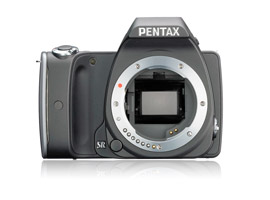
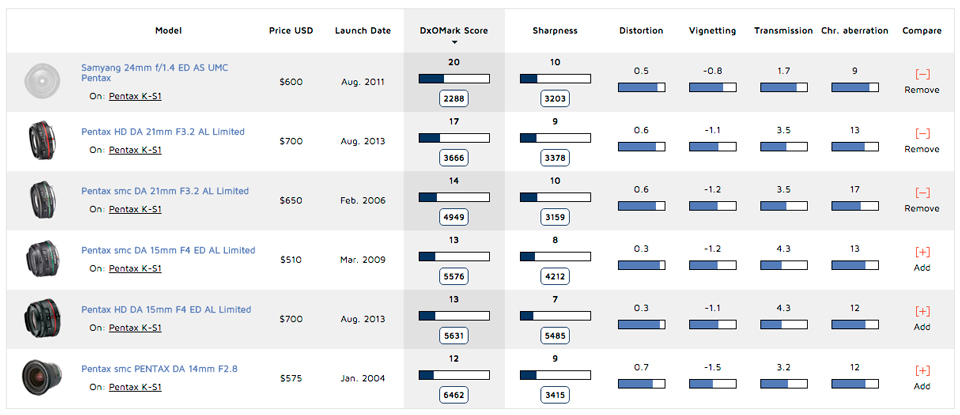
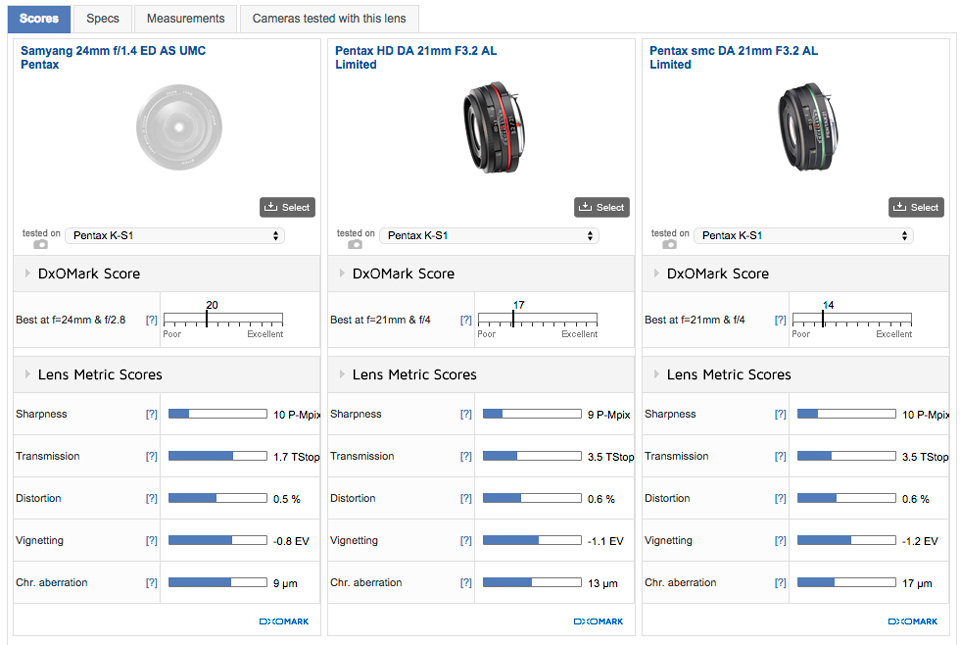
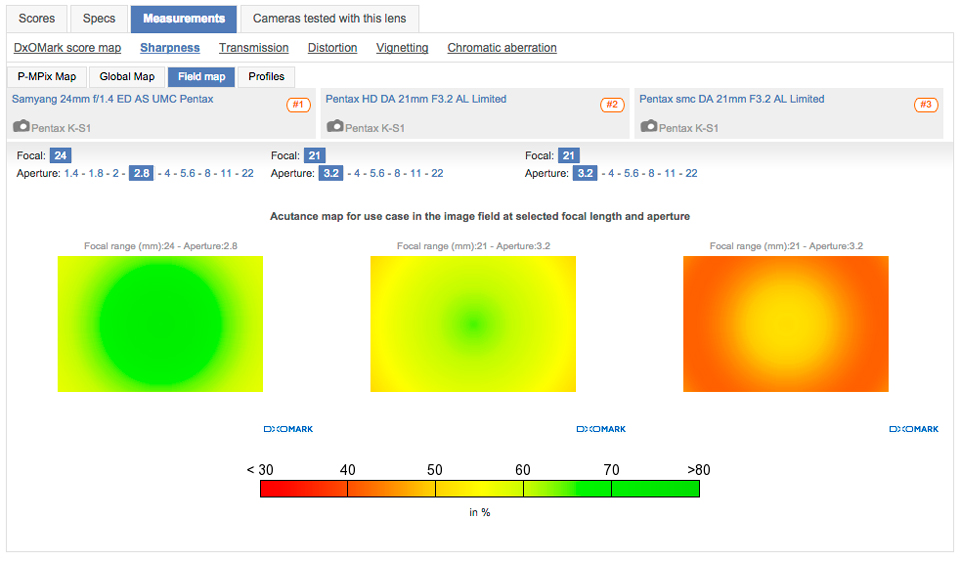
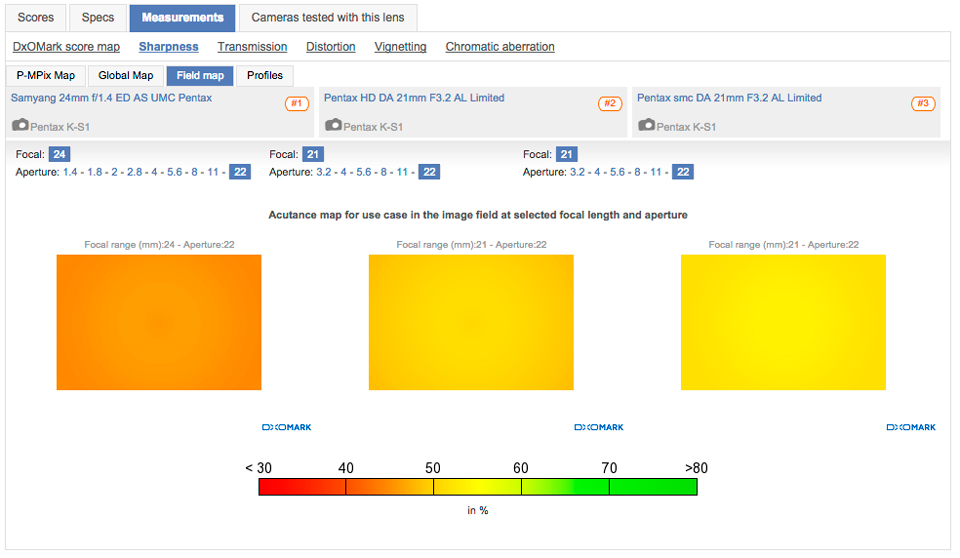
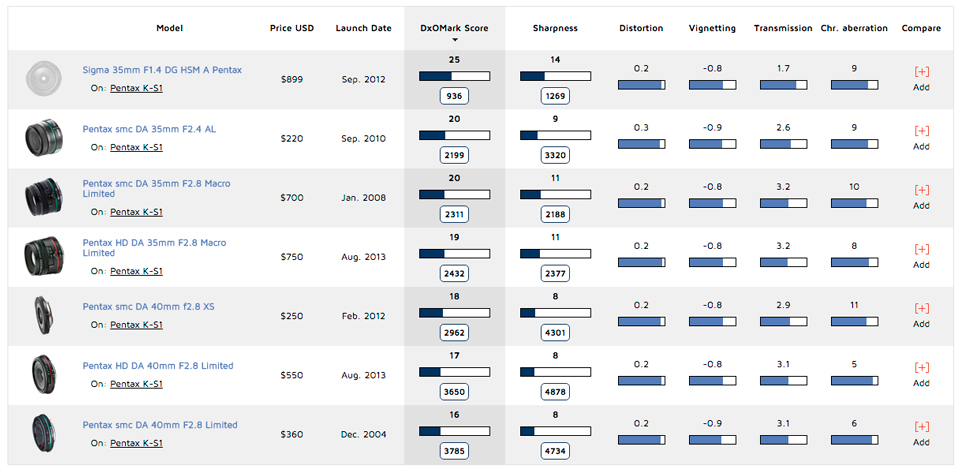

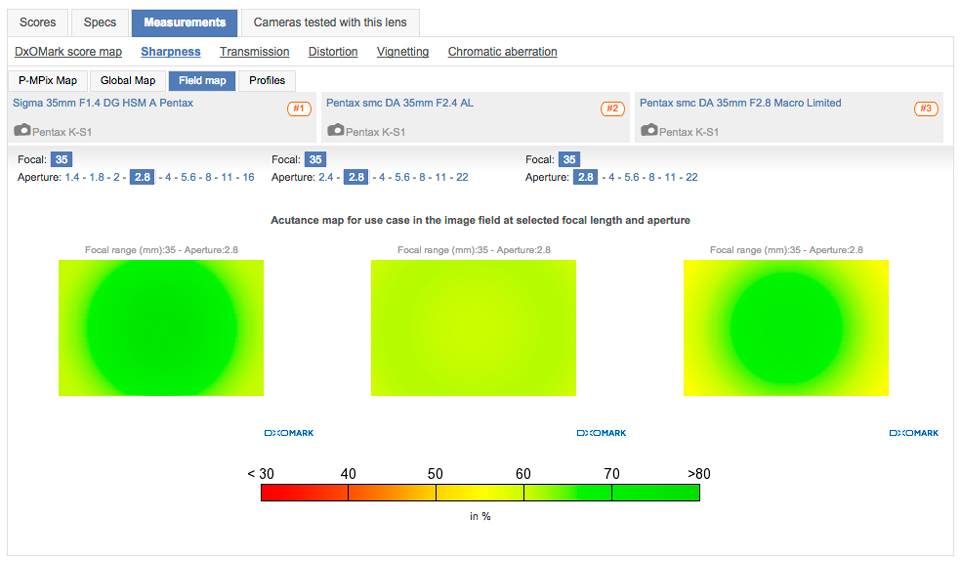
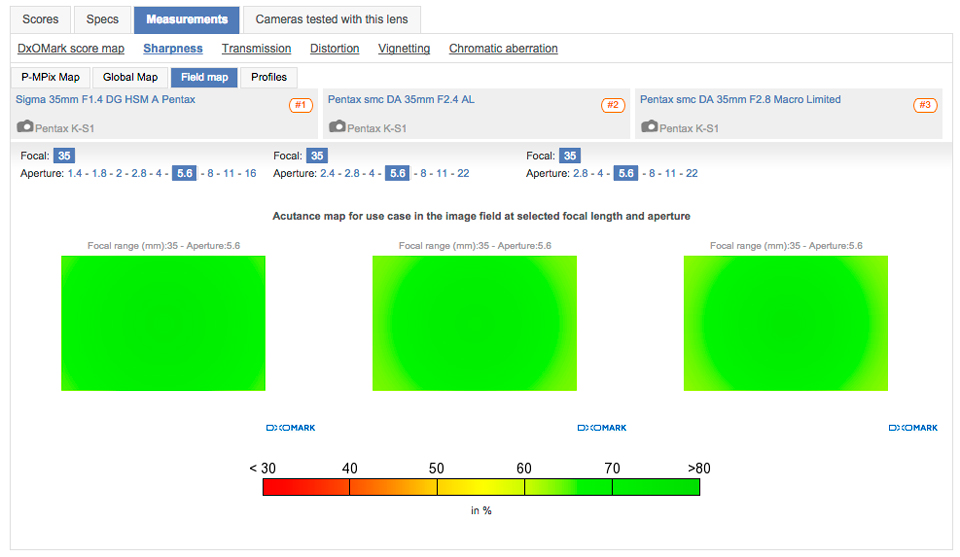
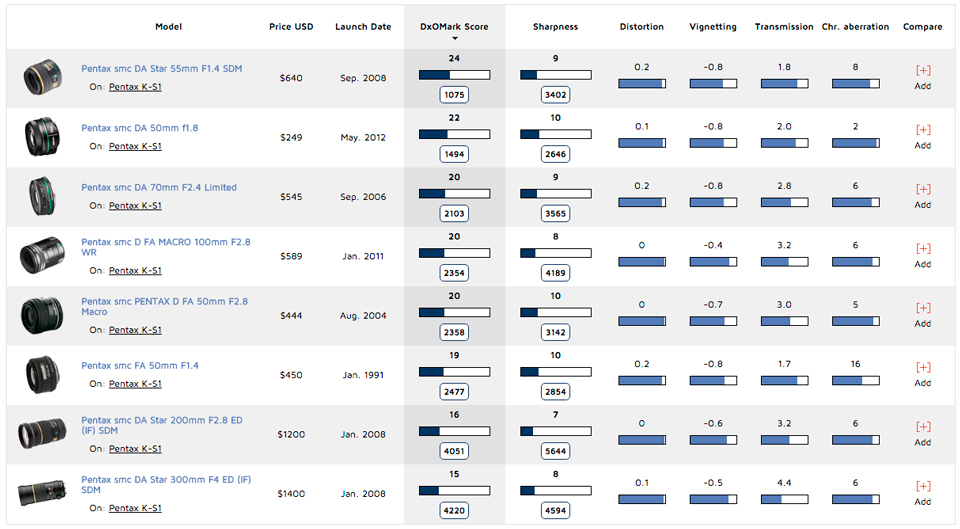

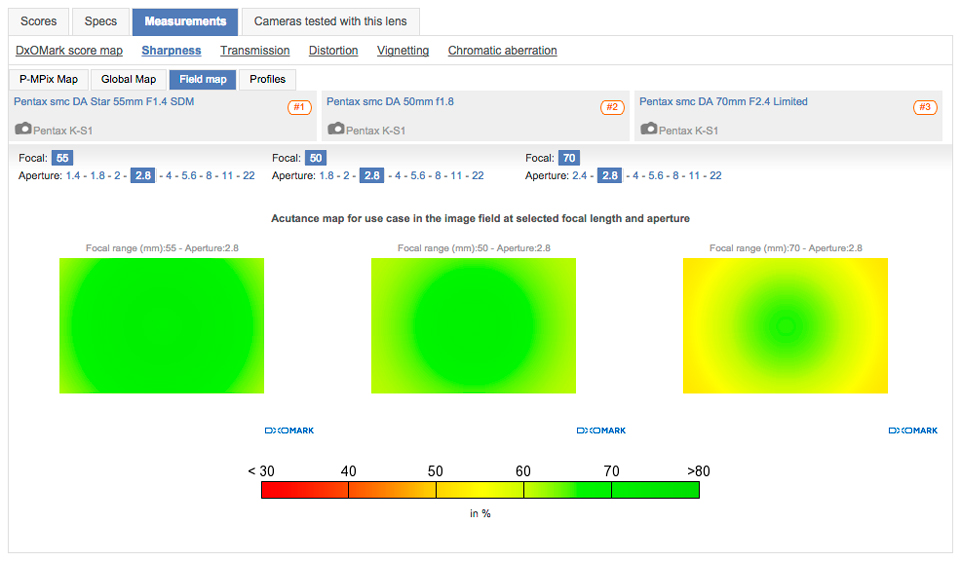




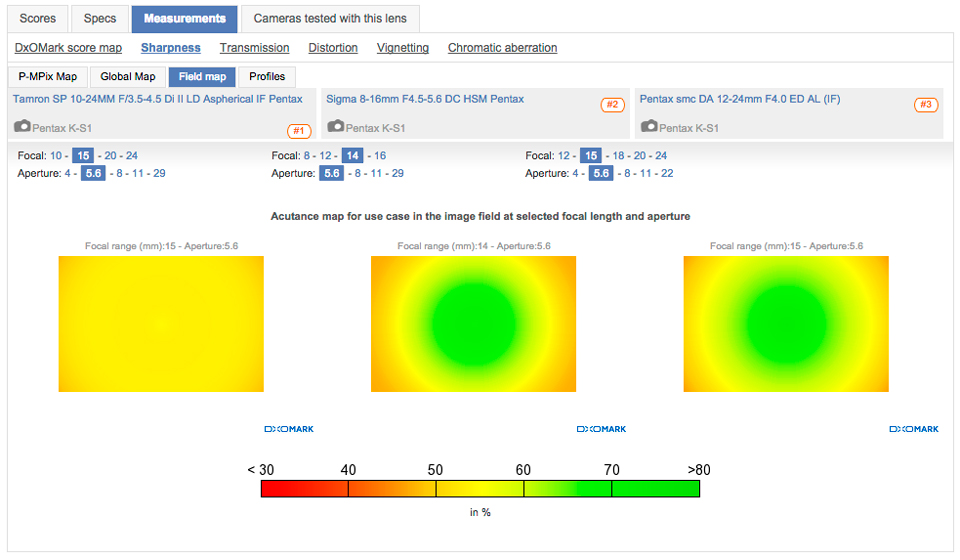
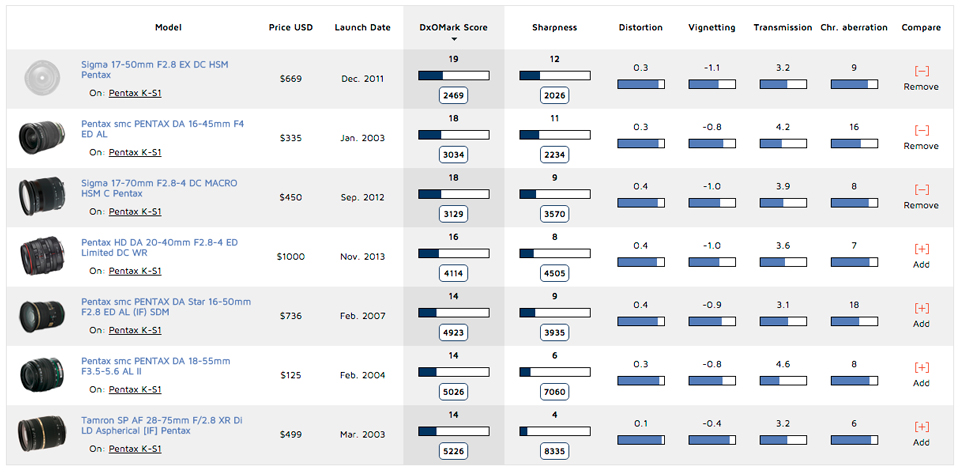

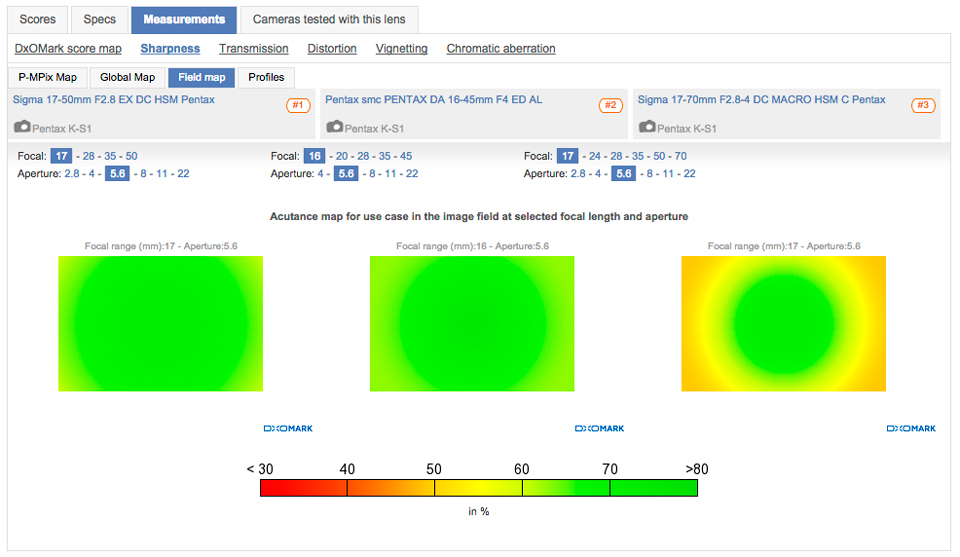
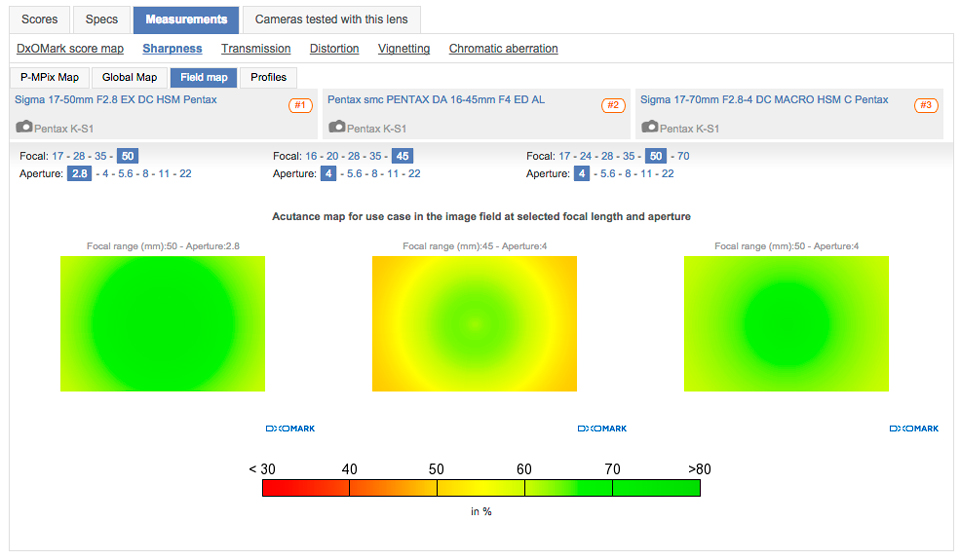
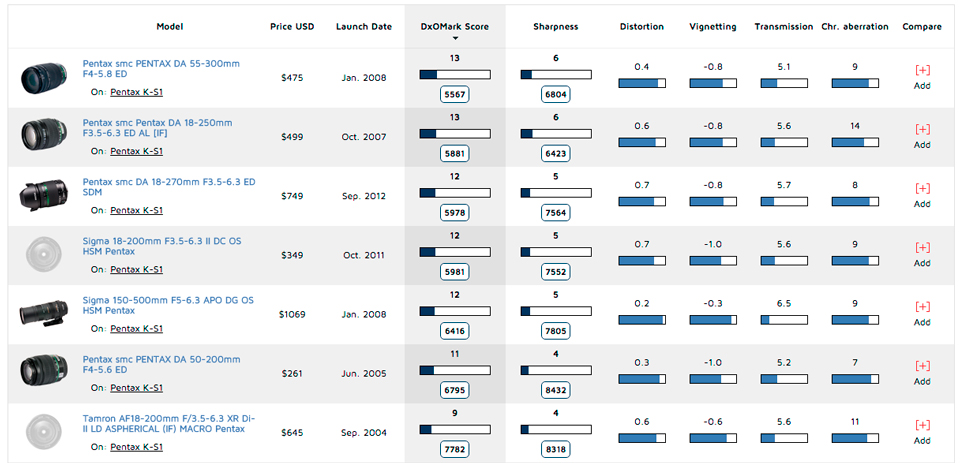

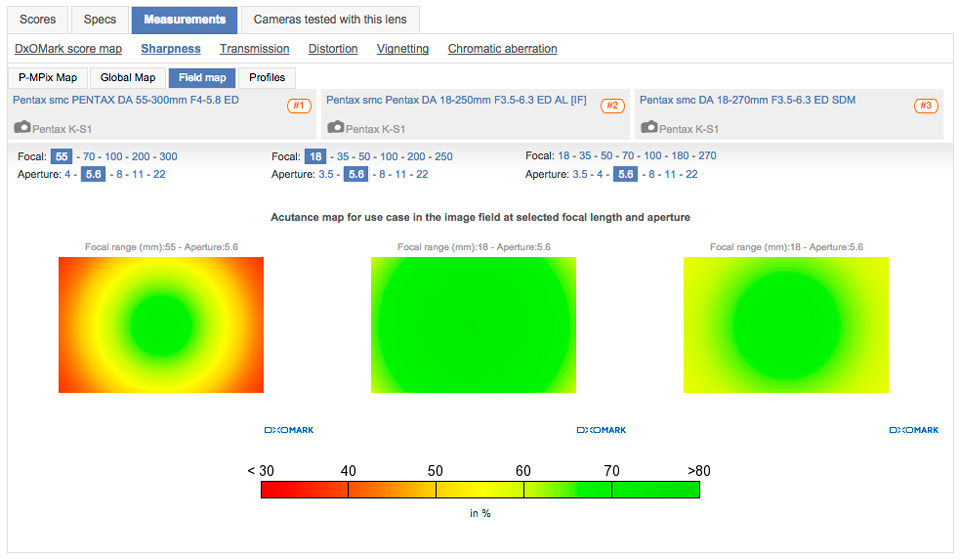


DXOMARK encourages its readers to share comments on the articles. To read or post comments, Disqus cookies are required. Change your Cookies Preferences and read more about our Comment Policy.